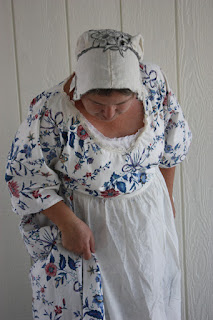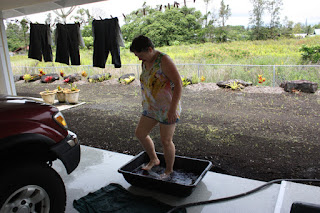Myself In My 18th Century Dutch Inspired Dress
This week has been a very busy one for me. My good friend Boone, has come back from his visit to the past, in Kentucky and Virginia. He has been so excited about his time there that he has encouraged me to get with it and make myself a nice 18th century garment too.
Well that was all well said, but when I attempted to make myself the typical English style clothes, the tightness of the fit, and the many layers, wreaked havoc with my heart condition, and the next thing you know it was beating all out of whack. That wouldn't do so I had to re-think the whole thing.
Since many of our family were Dutch from the Netherlands, I decided to research what their clothes were like. I was pleased to find out, that they wore bright fabrics nearly identical in pattern to the one I used above. They also wore a much looser fit of clothing than the English, and did not insist on wearing wale-bone stays, nor as many hot layers. They were given to farming and they used a much more practical style of clothing. Lucky for me, that they did.
I was pretty happy with the results, but will say, that I was in and out of this gown, for the pictures, pretty rapidly. It has been in the high 70's and but for a cool breeze, I don't think I could have stood it. Lucky for me, my friend lives at 4500 feet, further up the mountain, so it will be much cooler there.
I was so fortunate in the apron. It is very fine linen, and was given to me by Mom. It had been in her family for over one hundred years. She got it from grt. grandma Anne. I thought it went perfectly with my gown, and I shall be very careful when I wear it.
I had to take my shoes off, living in the tropics, can sure make wearing dress shoes a royal pain. Besides, I think it suits the peasant look I am going for far better.
Here you can see a bit of my bonnet. I made it from embroidered linen pieces, that were also given to me by Mom. They were already the perfect shape and had been her grandmothers too. The two small pieces, that went on the arms of her rocking chair, made up the brim of my bonnet and the back of the bonnet was made from a larger more rounded piece that went on the padded head rest on her rocker. The set was called, "Antimacassar's." All in all, I think it worked liked a charm.
I was reminded of these pieces I had, when I was looking at some bobbin lace Dutch bonnets in an online collection of a museum in Boston.
As you can see, the bonnet is covered in very nice embroidery, and cut-work. I even salvaged some old crocheted lace, that grandma had given me years ago, from an old rag of a pillowcase. This lace was made by grandma's maternal grandma, Mary Ann Zimmerman-Roberts. It was just the right length to trim out the neckline, of my bodice. I already had a very nice cotton under-slip, so I think it all came together nicely.
My friend Boone was very anxious to see how my garments turned out, so I had the pictures snapped even before I had, had a chance to press things. This shows a little better close up of the embroidery on the top of the bonnet. I had the most fun making it, and sewed it entirely by hand. The garments however, I sewed on my trusty old Kenmore, a machine that is now 36 years ago. For all of its age it is still running like a top today and has certainly served me well.
The fabric was some I had in my stash that had been a gift from a friend. The print pattern of the cloth is called Nantucket, and it very closely resembles that of a fabric on a Dutch gown, that resides in the Metropolitan Museum in New York. I was so excited to find that out, as it saved me untold dollars, and countless hours of search to find the right fabric. The only problem I encountered was that the blue fabric was polished to a high shine, so without further ado, I turned it to the back side, and instantly had indigo colored cloth minus the shine.
Most of our Dutch family dates to the 1600's, here in America. They came over as colonists to New Utrecht, in what is now Long Island, in New York City. They had large families and soon outgrew the space, so moved on from New York over to New Jersey, where they fought in the Revolutionary War. From there some moved to the Yadkin River Valley in North Carolina. Among them was Aaron Van Cleave, the 7th great grand-nephew, of my son Andrew. Aaron also happens to be, the 1st cousin 8 times removed, of my 1/2 brother, Philip. It was this Aaron, who bought the land belonging to Daniel & Rebecca Boone, and his daughter, Jane Van Cleave, that married Daniels brother, Squire Boone. They along with Daniel, took Boone's Trace, out to Kentucky, to Boonesborough, in the 1780's, and suffered along side him, all the privations of the savage wilderness.
Now all I need are some wooden shoes, and I would be the perfect, "Colonial Dutch", frontier "Hausfrau", (housewife.)
Well that was all well said, but when I attempted to make myself the typical English style clothes, the tightness of the fit, and the many layers, wreaked havoc with my heart condition, and the next thing you know it was beating all out of whack. That wouldn't do so I had to re-think the whole thing.
Since many of our family were Dutch from the Netherlands, I decided to research what their clothes were like. I was pleased to find out, that they wore bright fabrics nearly identical in pattern to the one I used above. They also wore a much looser fit of clothing than the English, and did not insist on wearing wale-bone stays, nor as many hot layers. They were given to farming and they used a much more practical style of clothing. Lucky for me, that they did.
I was pretty happy with the results, but will say, that I was in and out of this gown, for the pictures, pretty rapidly. It has been in the high 70's and but for a cool breeze, I don't think I could have stood it. Lucky for me, my friend lives at 4500 feet, further up the mountain, so it will be much cooler there.
I was so fortunate in the apron. It is very fine linen, and was given to me by Mom. It had been in her family for over one hundred years. She got it from grt. grandma Anne. I thought it went perfectly with my gown, and I shall be very careful when I wear it.
I had to take my shoes off, living in the tropics, can sure make wearing dress shoes a royal pain. Besides, I think it suits the peasant look I am going for far better.
Here you can see a bit of my bonnet. I made it from embroidered linen pieces, that were also given to me by Mom. They were already the perfect shape and had been her grandmothers too. The two small pieces, that went on the arms of her rocking chair, made up the brim of my bonnet and the back of the bonnet was made from a larger more rounded piece that went on the padded head rest on her rocker. The set was called, "Antimacassar's." All in all, I think it worked liked a charm.
I was reminded of these pieces I had, when I was looking at some bobbin lace Dutch bonnets in an online collection of a museum in Boston.
As you can see, the bonnet is covered in very nice embroidery, and cut-work. I even salvaged some old crocheted lace, that grandma had given me years ago, from an old rag of a pillowcase. This lace was made by grandma's maternal grandma, Mary Ann Zimmerman-Roberts. It was just the right length to trim out the neckline, of my bodice. I already had a very nice cotton under-slip, so I think it all came together nicely.
My friend Boone was very anxious to see how my garments turned out, so I had the pictures snapped even before I had, had a chance to press things. This shows a little better close up of the embroidery on the top of the bonnet. I had the most fun making it, and sewed it entirely by hand. The garments however, I sewed on my trusty old Kenmore, a machine that is now 36 years ago. For all of its age it is still running like a top today and has certainly served me well.
The fabric was some I had in my stash that had been a gift from a friend. The print pattern of the cloth is called Nantucket, and it very closely resembles that of a fabric on a Dutch gown, that resides in the Metropolitan Museum in New York. I was so excited to find that out, as it saved me untold dollars, and countless hours of search to find the right fabric. The only problem I encountered was that the blue fabric was polished to a high shine, so without further ado, I turned it to the back side, and instantly had indigo colored cloth minus the shine.
Most of our Dutch family dates to the 1600's, here in America. They came over as colonists to New Utrecht, in what is now Long Island, in New York City. They had large families and soon outgrew the space, so moved on from New York over to New Jersey, where they fought in the Revolutionary War. From there some moved to the Yadkin River Valley in North Carolina. Among them was Aaron Van Cleave, the 7th great grand-nephew, of my son Andrew. Aaron also happens to be, the 1st cousin 8 times removed, of my 1/2 brother, Philip. It was this Aaron, who bought the land belonging to Daniel & Rebecca Boone, and his daughter, Jane Van Cleave, that married Daniels brother, Squire Boone. They along with Daniel, took Boone's Trace, out to Kentucky, to Boonesborough, in the 1780's, and suffered along side him, all the privations of the savage wilderness.
Now all I need are some wooden shoes, and I would be the perfect, "Colonial Dutch", frontier "Hausfrau", (housewife.)








Comments